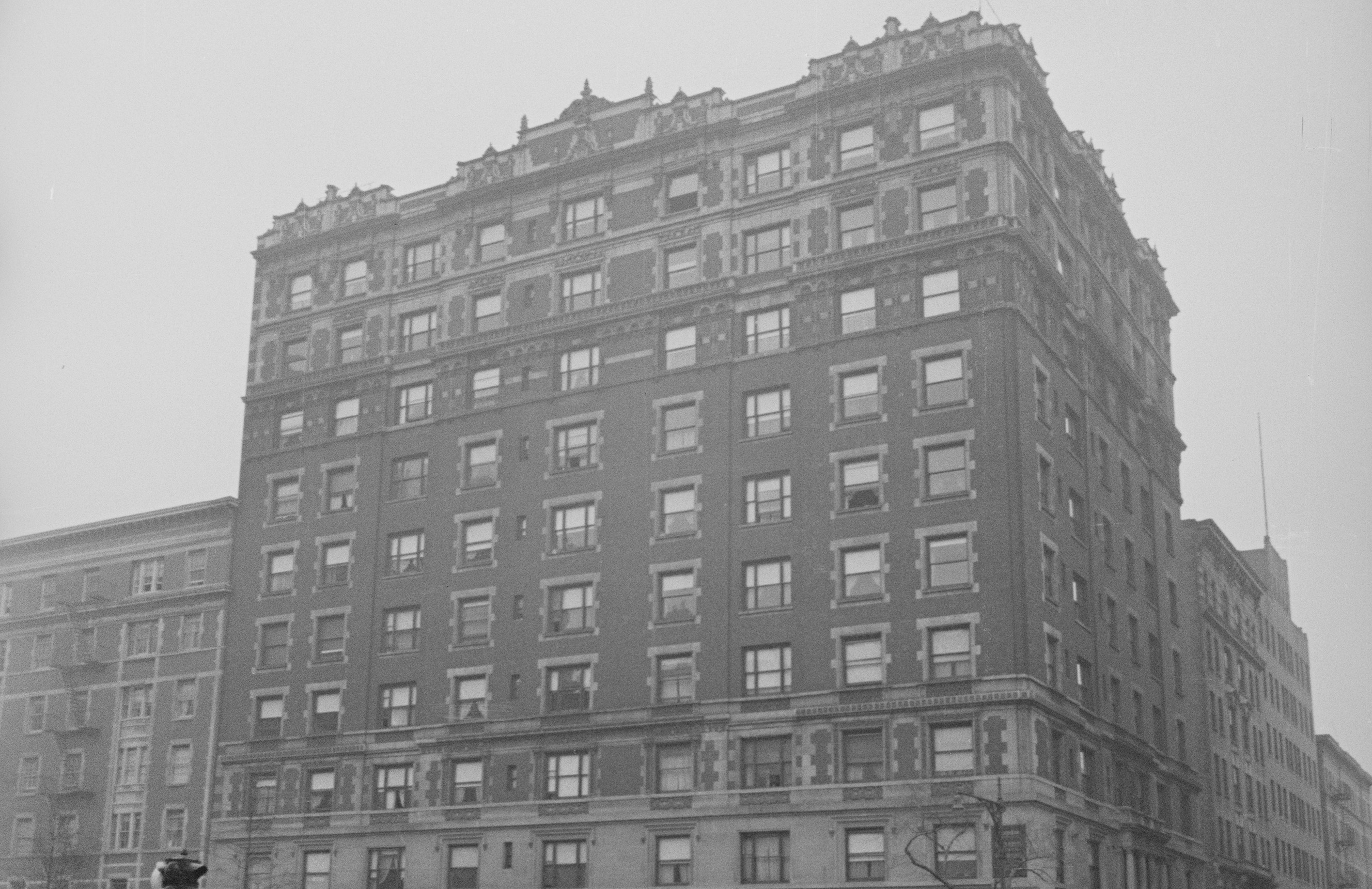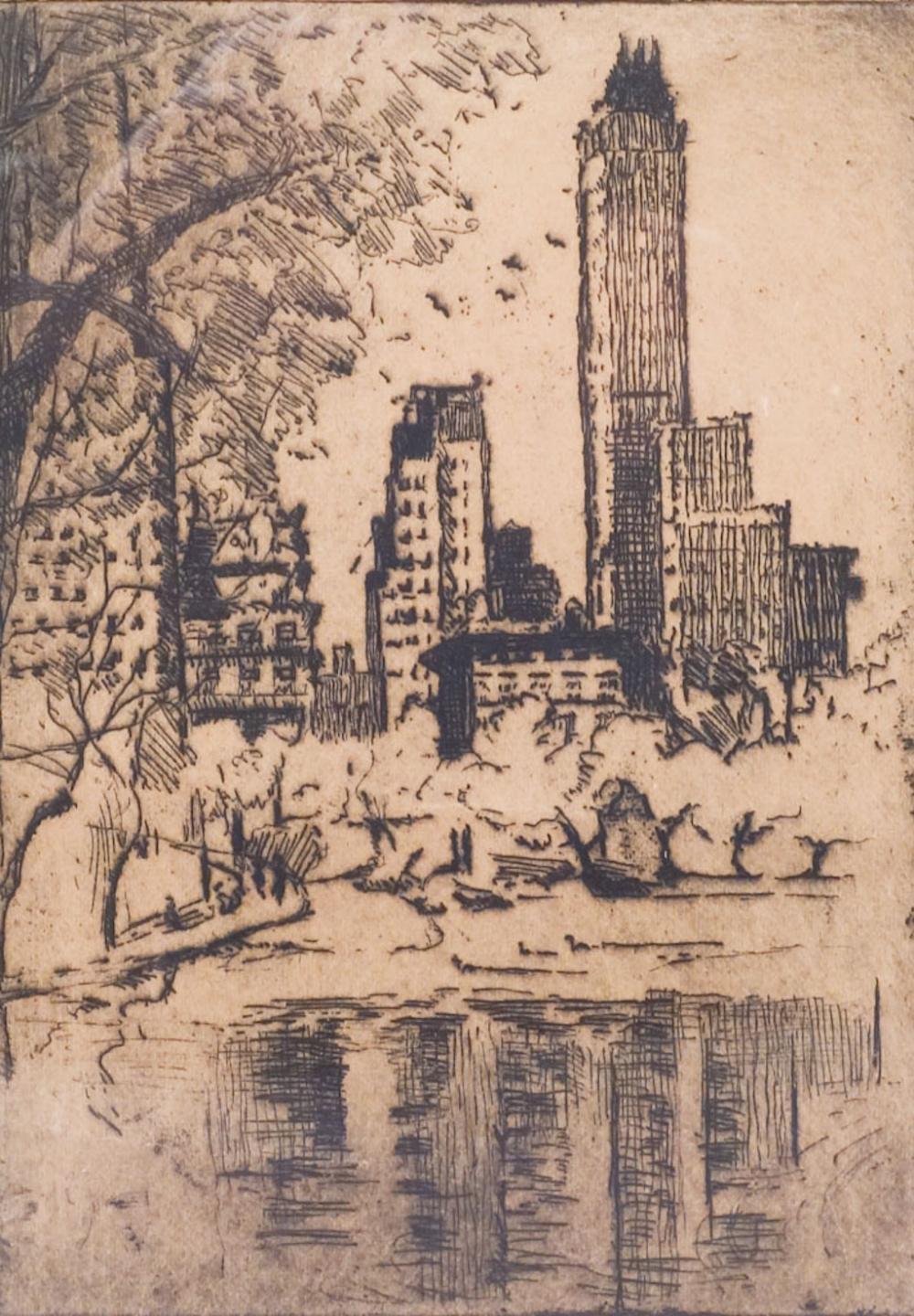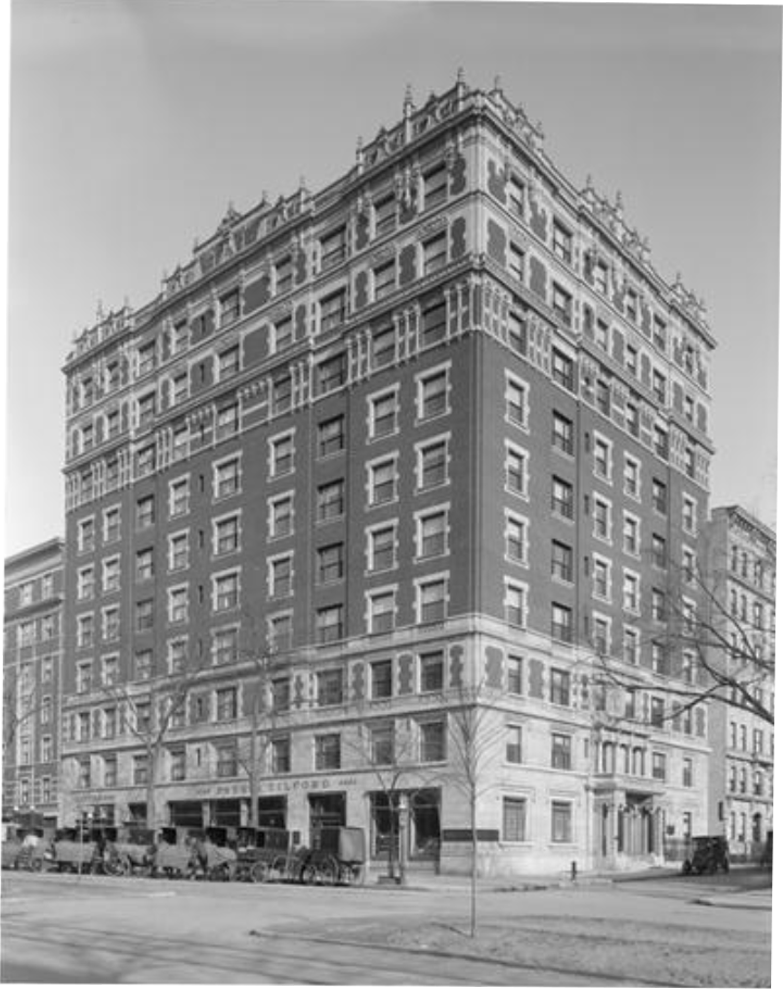
The Chepstow
by Tom Miller
In February 1906, the Central Realty Co. announced plans to erect “a 10-story elevator apartment house” on the northeast corner of Broadway and 101st Street. The firm promised, “The building will have the very latest improvements, and apartments will be arranged in suites for housekeeping purposes.” (The term “housekeeping” meant the apartments would have kitchens, unlike the popular residential hotels.)
The Chepstow, as it was called, was completed in 1907. The architectural firm of Mulliken & Moeller had produced a handsome brick and stone structure in the Renaissance Revival style. A two-story base of white limestone supported eight floors of red brick. The architects placed the regal, Renaissance-inspired residential entrance on the side street. The wide, arched doorway sat deeply recessed behind polished granite columns that upheld an ornate balcony with Corinthian columns and a carved heraldic panel. A faux balcony directly above carried on the motif, with intricate Renaissance Revival carvings and a large panel of a crown surrounded by foliate decorations.
On the Broadway side were a large store on the corner, occupied by the upscale grocery firm of Park & Tilford, and a smaller shop at 2668 which was leased by florist Charles Haberman. On September 7, 1907, The American Florist noted that Haberman “is now in a fine store in the new building 2668 Broadway.”
The sprawling apartments contained eight or nine rooms with three baths. They filled with well-to-do white-collar residents. Among the original occupants was John James Stevenson, a professor of Geology at New York University and a member of the Geological Society of American and the exclusive Century Club. Professor Stevenson would remain in the Chepstow into the 1920’s.
Mitchell Harrison, his wife, and their six-year-old son were also early tenants. Harrison was a former newspaper advertising agent and, according to The New York Times, “a man of independent means.” The couple lived in St. Louis until 1908 when, said the newspaper, Harrison “gave up his advertising business… because of ill health.” His medical condition seems to have been more psychological and physical. In January 1909, Harrison took to his bed and never got out. He was diagnosed with “nervous prostration.”
They had barely sat down in the living room when a loud report was heard.
On March 21, Harrison’s brother-in-law, Louis M. Lifter stopped by. The New York Times reported that Mrs. Harrison “joined them, and the three read and talked together. Harrison seemed to be very cheerful, yet he had at the time a note in his bed addressed to his wife asking her forgiveness for his suicide.” After a while, he said he wanted to sleep and the two left the bedroom.
They had barely sat down in the living room when a loud report was heard. Mrs. Harrison ran to the bedroom and “saw a little cloud of smoke floating upward from the bed.” She threw open a window and screamed to the street for help. “Get a doctor!” Harrison was still alive when the doctor arrived but died before the ambulance got to the building. The coroner’s physician found Harrison’s letter to his wife in the bed, which read:
I did what seemed to be best under the circumstances. Please forgive me and bear up under your trouble for baby’s sake. It breaks my heart to leave you—I so dearly love you and our darling boy. God bless you both. Your Loving Husband
Artist Mabel R. Ward lived in the Chepstow in 1912, as did Robert Adamson and his wife, the former Ethel McClintock. Adamson had been a newspaper editor and political writer until January 1, 1910 when he became secretary to Mayor William Jay Gaynor.
The mayor and his son set sail for Europe on the RMS Baltic on September 4, 1913. Seven days later a telegram from Rufus Gaynor arrived at the Chepstow for Robert Adamson. It read, “Father died Wednesday at 1 o’clock. Death due to heart failure. Notify mother.” Gaynor’s successor, Mayor Ardolph L. Klein, kept Adamson on as his secretary. Then, after managing his campaign in 1913, on January 1, 1914, Mayor John Purroy Mitchel appointed Adamson Fire Commissioner.
A heart-warming incident played out in the Adamson apartment on Thanksgiving Day 1916. Firefighter Jack Walsh had earlier “scaled a seven story building and rescued a young lady at the risk of his life,” according to The Advocate. The 32-year-old was on duty that day, when his captain informed him that he was to report to the Commissioner’s apartment. He later told a reporter, “As I entered the Commissioner’s house I was greeted by Mrs. Adamson, and still I wondered what the urgent call was all about. A minute later the ‘Big Boss’ appeared and said, ‘Fireman, glad to see you. Did you have your turkey yet?” The young hero not only shared Thanksgiving dinner with the Fire Commissioner and his wife, but was handed $100 in appreciation for his bravery, donated by a citizen.
Augustus C. Corby, the vice-president of the Metropolitan Bank lived here in 1921. He had just returned home on the night of June 15 when he had to rush back to the bank. Frederick J. Schweer, Jr., a young clerk had taken a pile of bank books and records into a large vault when the heavy door slammed shut. Schweer was now trapped inside an airtight vault and the bank’s employees had all gone home.
Around an hour later, at 7:00 the night watchman, John Connolly, was making his rounds and heard a steady tapping on the door of the vault. He first thought someone was trying to break in, then realized an employee was trapped inside. Connolly rushed to the telephone and called Corby, who had the combination. Before leaving his apartment, Corby notified police. The Massachusetts newspaper, the Greenfield Daily Recorder reported, “His automobile was outside and he broke all traffic regulations getting to the bank.” Once there, and with policemen standing by, he opened the vault. The article said, “The boy was unconscious when lifted out. An ambulance surgeon from Bellevue hospital, who had been waiting more than an hour with a pulmotor, began work on him.” Schweer had been rescued with only moments to spare.
At the time of the nerve-wracking rescue, tenants paid the equivalent today of $3,900 per month for an eight-room apartment, and $4,400 for nine-rooms. The Broadway stores had been divided into three shops that year. Morris Burnstein’s cigar store was in the corner space, the Buckingham Haberdashers moved into the middle store, and the northernmost space was a lingerie shop.
Expectedly, families living in the Chepstow employed servants, at least a maid and a cook. The Jordan Lamberts’ maid was Viola Smith. Although the building, of course, had electricity, the 25-year-old was using an alcohol lamp on the night of November 15, 1925. Her choice nearly ended her life. The Daily News reported, that while carrying the lamp, she tripped and fell.
“Her clothes and the pantry caught fire. Mrs. Lambert rushed to the screaming maid and beat out the flames with her hands, suffering slight burns as she did so.” Viola Smith was taken to Knickerbocker Hospital, where her condition was deemed serious.
At the station house McBride explained his actions saying, “I must have been crazy drunk.”
The days of expansive suites and affluent residents came to an end in the World War II years. In 1945, the Chepstow was converted to a warren of single occupancy units. Living in a room here in 1955 was Frank “Frisco” McBride, a 31-year-old portrait artist in the Times Amusement Corp. Arcade on Broadway near 52nd Street.
Around 3:00 on the morning of September 16 that year, an inebriated McBride was on Broadway, just north of Times Square. A man, possibly accidentally, knocked him to the sidewalk. The Herald Statesman reported, “McBride got up, clutching a beer can opener, and ‘proceeded to terrorize about 150 people in the vicinity,’ police said.” When Detectives Ury and Massello attempted to apprehend him, McBride lunged at Massello with the opener. In the affray that followed, Detective Ury’s right index finger was broken. At the station house McBride explained his actions saying, “I must have been crazy drunk.”
A renovation completed in 1965 resulted in nine apartments per floor. Whether Edward McBride was a relative of Frisco McBride is unclear, but he was living here in 1973 when he was arrested on May 10 with two other men. They were charged with robbing a man named Larry Grant of his 1971 Chrysler and cash, as well as gun possession. As the police van was transporting them to the 24th Precinct Station on West 100th Street the following morning, the rear doors swung open. All five prisoners, including McBride, jumped out—two of them handcuffed together—and fled without the policemen in the front of the van realizing what had happened.
But eluding police while in handcuffs proved both difficult and awkward. McBride walked into the Criminal Court Building on Centre Street a day later to give himself up. He told officials that “he had spent most of Friday riding subways around town and had gone to see ‘Fists of Fury’ that evening at the National Theater in Times Square, sitting through it four times.”
As the 20th century drew to a close, Oscar and Toni’s bar occupied the corner store. The 1994 New York: The Rough Guide called it “a neighborhood bar that’s popular with locals, especially students from nearby Columbia University.” It made way for the Broadway Dive in 1999. Fodor’s Travel Guide said, “It may be called a dive, but this dimly lit, wood-clad bar, covered with various animal busts, is more like a craft beer emporium.” The Broadway Diner (originally the Broadway Restaurant) has been in the space next door since around 2013.
Tom Miller is a social historian and blogger at daytoninmanhattan.blogspot.com
Building Database
Keep Exploring
Be a part of history!
Think Local First to support the businesses at 2660-2668 Broadway:
Meet Awilda Sosa!
Meet Nick and Lee Seinfeld!




